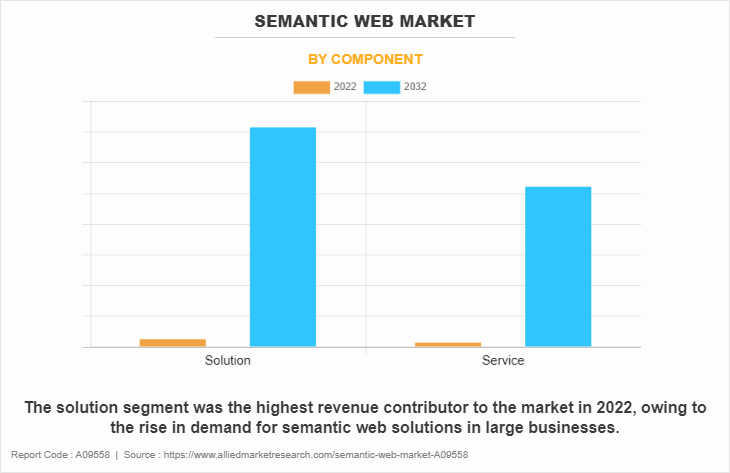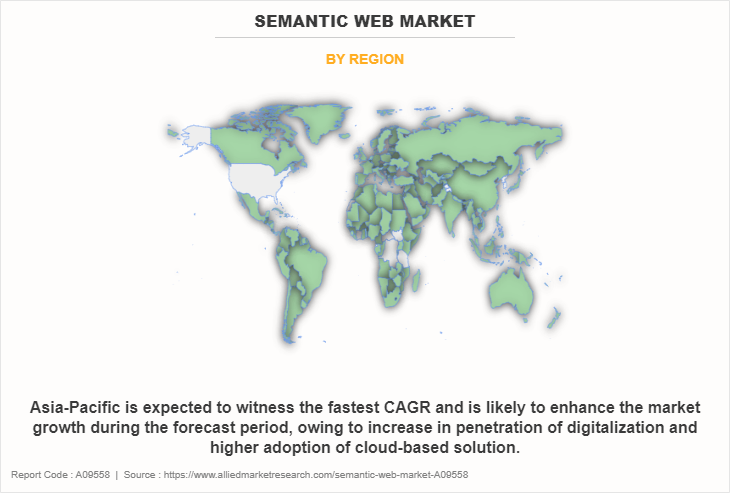Semantic Web Market Insight, 2032
The global semantic web market was valued at $3.7 billion in 2022, and is projected to reach $123.5 billion by 2032, growing at a CAGR of 42.4% from 2023 to 2032.
Rise in the adoption of data management solutions, web 3.0 and increasing adoption of semantic web solutions in businesses is expected to positively impact the growth of the market in the future. In addition, the surge in need for language processing and multilingual applications are driving global market growth. However, data privacy and security and lack of knowledge and data quality and standardization errors hamper market growth. Furthermore, growing integration of AI and ML technologies and implementation of IoT technology create opportunities for semantic web market growth.

The semantic web is a collection of technologies and standards intended for providing semantic meaning to web content, allowing for more effective information identifying and processing. In addition, it entails using ontologies and knowledge representation languages to define the connections between various items and concepts on the internet. The semantic web enables greater data integration, advanced search capabilities, and more complex applications that can deliver context-aware replies to user queries by enriching data with semantic annotations.
Moreover, the rising usage of analytics, the increased volume of metadata, which provides a greater experience, and the development of real and augmented artificial intelligence (AI) are all key driving factors for the market's growth. Additionally, improved automation, personalization, easy information retrieval, data usability, knowledge discovery are some additional drivers that fuel the semantic web market forecast.
In addition, semantic web is useful for online content and search engines because it allows these platforms to better grasp the context and interactions between multiple types of information. This leads to more accurate and relevant search results, making it simpler for consumers to locate the information.
In addition, semantic web provides logical reasoning and inference based on the relationships defined in ontologies. It also enables computers to derive new knowledge from existing data, making it possible to answer more complex queries and perform advanced analysis. Moreover, the structured and linked data provided by the semantic web can enhance machine learning (ML) and artificial intelligence (AI) algorithms. Such enhanced factors are expected to provide lucrative opportunities for semantic web industry growth during the forecast period.
Segment Review
The semantic web market is segmented into component, deployment type, enterprise size, industry vertical, and region. By component, it is bifurcated into solution and service. By deployment type, it is divided into public, private and hybrid. By enterprise size, it is categorized into large enterprises and small and medium-sized enterprises. By industry vertical, the market is classified into BFSI, IT and telecom, retail and e-commerce, healthcare and life science, media and publishing, government and public sector, education, and others. Region wise, it is analyzed across North America, Europe, Asia-Pacific, and LAMEA.

On the basis of component, the global semantic web market share was dominated by the solution segment in 2022 and is expected to maintain its dominance in the upcoming years, owing to the demand for robust data integration capabilities, ease of use, compatibility with different platforms. However, the service segment is expected to witness the highest growth, owing to the increasing adoption of managed web services in several organizations to provide convenience, expertise, and all-time support, allowing organizations to focus on their core business functions.

By region, North America dominated the semantic web market share in 2022. The region has increased adoption of advanced technologies such as web 3.0 innovations and infrastructure, which further anticipated to propel the growth of the semantic web market. However, Asia-Pacific is expected to exhibit the highest growth during the forecast period. The region is experiencing a rise in demand for digitalization and high internet penetration, which is expected to provide lucrative growth opportunities for the market in this region.
Top Impacting Factors
The Rise in the Adoption of Data Management Solutions:
The rise in the adoption of data management solutions in several industries to improve data optimization is directly influencing the growth of the global semantic web market. Radical advancements in the digital environment, enabled through communication technologies, require revising present business models and maintenance strategies. Consequently, semantic web services are gaining significant adoption to increase the use of IT and control systems among software operators, particularly data management and other digital technologies. Increased use of data management and digital solutions helps business managers to improve data integration and quality of data. These factors are expected to contribute to the increased installation of the semantic web market, globally.
Furthermore, the integration of effective data management solutions allows businesses to share data across different systems. In addition, the rising demand for interoperability in several businesses provides numerous opportunities for the global market. Hence, these multiple benefits offered by data management services will boost the demand for the semantic web market. Moreover, regional government and business authorities are continuously involved in promoting digitalization in business operations and maintenance. For instance, in May 2023, Semantic Web Company partnered with TetraScience. Through this partnership, the businesses help biopharmaceutical customers derive more insights from their scientific data through meaningful semantic search across their organizations. Such strategies pooling in the digitalizing of data management will fuel the demand for semantic web services, which in turn, augment the market growth on a global scale.
Increase in Adoption of Semantic Web in Businesses:
The increasing investment by public and private businesses to expand smart infrastructure is impacting market growth. The rise in need for data integration and interoperability services in several businesses further propels the growth of the semantic web in businesses. This is attributed to the rising number of countries committing to reducing the stress added to data management caused by the huge amount of data generation by various devices. Further, government policies are undertaking increased initiatives to embrace advanced technology, with plans for integrating a new digital data management system. Therefore, the semantic web gained wider traction among end-users, which in turn drive the market growth.
Moreover, several industries such as healthcare, finance, and education, are adopting the semantic web to create domain-specific models and knowledge models that handle distinct issues and needs. For instance, in June 2020, Semantic Web Company partnered with Ontotext, to offer superior support for all three loops (users, experts, automation) along the entire knowledge graph lifecycle from requirement gathering and data discovery to development, usage, maintenance, and evolution. Such initiatives and advancements in businesses will eventually contribute to the growth of the global semantic web market.
COVID-19 Impact Analysis
The global semantic web market has witnessed stable growth during the COVID-19 pandemic, owing to the rapidly increased digital penetration during the period of COVID-19-induced lockdowns and stringent social distancing policies. This further fueled the demand for semantic web services to enable users to enhance their online presence. The pandemic has further driven the digital transformation in several industries including manufacturing, healthcare and others. These factors have directly impacted on the economy of these sectors. On the other hand, the outbreak demonstrated the need of real-time data analysis and the need to make knowledgeable choices quickly.
Semantic web technologies have the potential to play an important role in gathering and analyzing disparate data sources, giving significant insights to fight the worldwide epidemic and address related difficulties. This will boost the demand for semantic web solutions in several sectors. Consequently, these factors are expected to have a positive impact on the growth of the global semantic web market trends. In the long-run outlook, the market witnessed a significant upturn, owing to the robust demand for digital technologies across the world and escalating use of digital services in semantic web post the COVID-19 pandemic, thus accelerating market growth.
Key Benefits for Stakeholders
- The study provides an in-depth semantic web market analysis along with the current trends and future estimations to elucidate the imminent investment pockets.
- Information about key drivers, restraints, and opportunities and their impact analysis on the semantic web market size is provided in the report.
- The Porter’s five forces analysis illustrates the potency of buyers and suppliers operating in the semantic web industry.
- The quantitative analysis of the global semantic web market for the period 2022–2032 is provided to determine the semantic web market potential.
Semantic Web Market Report Highlights
| Aspects | Details |
| Market Size By 2032 | USD 123.5 billion |
| Growth Rate | CAGR of 42.4% |
| Forecast period | 2022 - 2032 |
| Report Pages | 285 |
| By Component |
|
| By Deployment Type |
|
| By Enterprise Size |
|
| By Industry Vertical |
|
| By Region |
|
| Key Market Players | Franz Inc., TopQuadrant, NetBase Quid, Semantic Web Company, Altova, Ontotext, Cambridge Semantics, Microsoft Corporation, OpenLink Software Inc., Cycorp Inc. |
Analyst Review
As the semantic web market continues to evolve. Businesses recognize that the semantic web may aid in the integration and analysis of varied datasets from both internal and external sources. This may offer useful insights and promote data-driven decision-making, resulting in increased operational efficiency and a competitive edge. In addition, semantic web technologies allow for the creation of personalized consumer experiences, customized product suggestions, and targeted marketing campaigns. Such factors are expected to provide lucrative opportunities for market growth during the forecast period.
Furthermore, adopting semantic web technology can help an enterprise establish itself as an industry innovator. Businesses recognize that by embracing these technologies, their companies may gain a competitive advantage by providing more intelligent and contextually appropriate goods and services. However, businesses also recognize the challenges associated with semantic web services. One potential risk is the complexity of implementation challenges, this type of software is complicated to deploy and use, that may require technical knowledge and additional processes to design and maintain, which can make it challenging for organizations to enhance their product offerings in web services. In addition, semantic web services require significant investment in software infrastructure and technological expenses, which can be a barrier to the growth of global industry.
Furthermore, interoperability issues between the network of devices must be addressed. As there could be incompatibilities between the software’s and hardware used by various semantic web solutions. Businesses must integrate software or applications based on specific standards and protocols. By addressing these challenges, companies can unlock the full potential of the semantic web to transform their business operations, create value, and gain a competitive advantage in their industry. For instance, in June 2023, Semantic Web Company partnered with TetraScience. Through this alliance, both companies intend to help biopharmaceutical customers to utilize relevant semantic analysis throughout their organizations to gain greater understanding from the scientific data.
The North America is the largest market for the Semantic Web.
Factors such as increasing adoption of internet devices and growing demand for flexible security services across various businesses are expected to fuel the growth of the market during the forecast period.
Semantic web industry is anticipated to generate $123,515.04 million by 2032.
The key growth strategies for Semantic Web include product portfolio expansion, acquisition, partnership, merger, collaboration and others.
Altova, Cycorp Inc, NetBase Solutions Inc., OpenLink Software Inc., Semantic Web Company and others.
Loading Table Of Content...
Loading Research Methodology...



